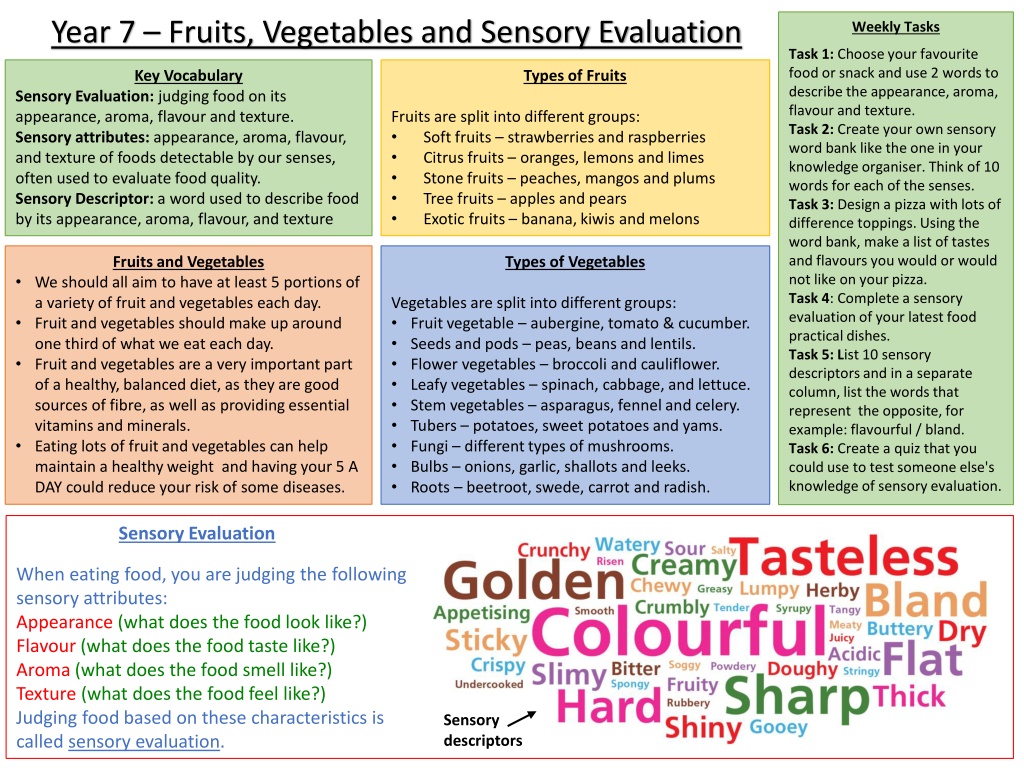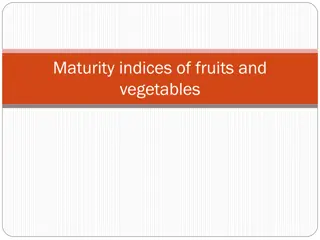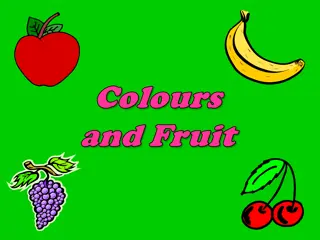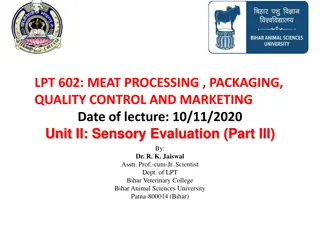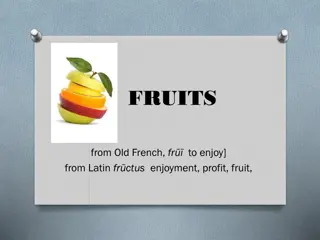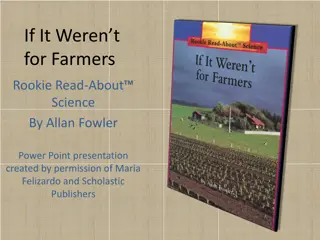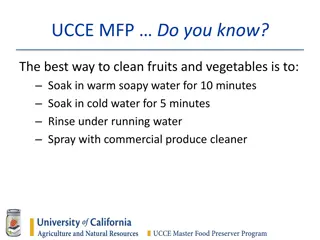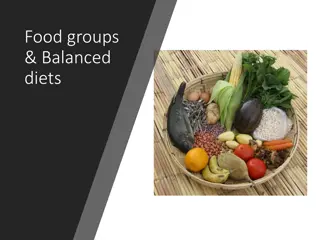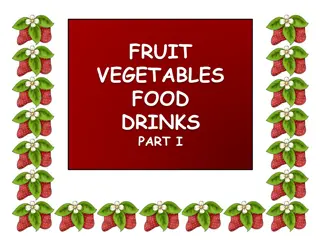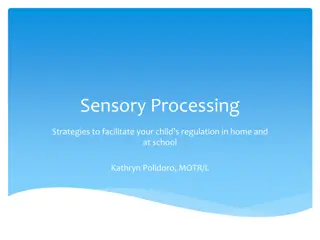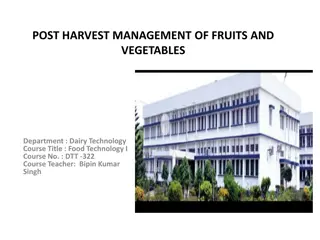Exploring Fruits, Vegetables, and Sensory Evaluation in Food Science
Delve into the world of fruits, vegetables, and sensory evaluation through engaging tasks like describing favorite foods, creating sensory word banks, designing unique pizzas, and conducting sensory evaluations. Learn about different types of fruits and vegetables, their importance in a balanced diet, and key sensory attributes to assess food quality.
Download Presentation

Please find below an Image/Link to download the presentation.
The content on the website is provided AS IS for your information and personal use only. It may not be sold, licensed, or shared on other websites without obtaining consent from the author. Download presentation by click this link. If you encounter any issues during the download, it is possible that the publisher has removed the file from their server.
E N D
Presentation Transcript
Year 7 Fruits, Vegetables and Sensory Evaluation Weekly Tasks Task 1: Choose your favourite food or snack and use 2 words to describe the appearance, aroma, flavour and texture. Task 2: Create your own sensory word bank like the one in your knowledge organiser. Think of 10 words for each of the senses. Task 3: Design a pizza with lots of difference toppings. Using the word bank, make a list of tastes and flavours you would or would not like on your pizza. Task 4: Complete a sensory evaluation of your latest food practical dishes. Task 5: List 10 sensory descriptors and in a separate column, list the words that represent the opposite, for example: flavourful / bland. Task 6: Create a quiz that you could use to test someone else's knowledge of sensory evaluation. Key Vocabulary Types of Fruits Sensory Evaluation: judging food on its appearance, aroma, flavour and texture. Sensory attributes: appearance, aroma, flavour, and texture of foods detectable by our senses, often used to evaluate food quality. Sensory Descriptor: a word used to describe food by its appearance, aroma, flavour, and texture Fruits are split into different groups: Soft fruits strawberries and raspberries Citrus fruits oranges, lemons and limes Stone fruits peaches, mangos and plums Tree fruits apples and pears Exotic fruits banana, kiwis and melons Fruits and Vegetables Types of Vegetables We should all aim to have at least 5 portions of a variety of fruit and vegetables each day. Fruit and vegetables should make up around one third of what we eat each day. Fruit and vegetables are a very important part of a healthy, balanced diet, as they are good sources of fibre, as well as providing essential vitamins and minerals. Eating lots of fruit and vegetables can help maintain a healthy weight and having your 5 A DAY could reduce your risk of some diseases. Vegetables are split into different groups: Fruit vegetable aubergine, tomato & cucumber. Seeds and pods peas, beans and lentils. Flower vegetables broccoli and cauliflower. Leafy vegetables spinach, cabbage, and lettuce. Stem vegetables asparagus, fennel and celery. Tubers potatoes, sweet potatoes and yams. Fungi different types of mushrooms. Bulbs onions, garlic, shallots and leeks. Roots beetroot, swede, carrot and radish. Sensory Evaluation When eating food, you are judging the following sensory attributes: Appearance (what does the food look like?) Flavour (what does the food taste like?) Aroma (what does the food smell like?) Texture (what does the food feel like?) Judging food based on these characteristics is called sensory evaluation. Sensory descriptors
Year 8 Cereal Grains, Potatoes and Dairy Foods Key Vocabulary Weekly Tasks Potatoes Task 1: Research how wheat is processed into flour. Create a timeline to show the process. Task 2: List the different type of milk you can buy in a shop. Research and explain what the process of skimming is. Task 3: Create your own 3 course menu the starter should contain grains, the main should contain potato, and the dessert should have dairy. Task 4: List the nutrients that are provided by cereal grains, potatoes and dairy foods. Are you getting enough of these in your diet? Task 5: Wheat (Gluten) and Dairy (Milk) are common allergies, research and discuss alternatives for both. Task 6: Potato products are common in supermarkets, check out the frozen section of supermarket freezers/websites and make a list of the products available. Cereals cultivated grasses. The grains are used as a food source. Gluten the protein found in wheat. Fibre the nutrient found in the cell walls of cereal grains helps the digestive system. Although potatoes are vegetables, a potato is actually a tuber. Tubers grow from roots. In the Eatwell guide, potatoes are included in the starchy foods section. Cereal Grains Different potato varieties have different qualities and uses: Floury Potatoes fall apart when cooked, such as Maris Pipers and King Edward. They are very good for baking and mashing. Recipes using floury potatoes include cottage pie, jackets potatoes, roast potatoes and hash browns. Waxy Potatoes such as Charlotte or Jersey Royals hold together when steamed or boiled. Recipes using waxy potatoes include potato salad, dauphinoise potatoes and cubed in soups. Cereal grains grow on cultivated grasses. The grains can be eaten as a food source. Common cereal grains include wheat, oats and rice. Wheat Wheat is used in the production of flour and bread products. Flour needs to be processed in order to make flour. This process is called milling. This removes the outer layer of the grain and grinds the grain into flour. The type of flour depends on the extraction rate this is the percentage of the wheat grain found in the flour: 100 percent extraction rate is the wholegrain, which provides wholegrain flour. 85 percent extraction rate provides brown flour. 70 percent extraction rate is the wholegrain, which provides white or plain flour. Dairy Foods Dairy products are foods made using the milk of a cow, goat or sheep. Cow s milk is most commonly used to make cheese and yoghurt. Bacteria, called starter cultures, are needed to make cheese and yoghurt. This causes the lactose (sugar in milk) to turn into lactic acid, which adds flavour and makes the product last longer. These flours can used to make lots of different products including breads, cakes, pasta, and biscuits.
Year 9 Functional Properties of Fats Weekly Tasks Key Vocabulary Plasticity Plasticity Aeration: adding air to a food product. Plasticity melting temperature of a fat or lipid. Shortening providing a crumbly texture. Fats do not melt at fixed temperatures, but over a range. This property is called plasticity. It gives all fats unique characteristics. Task 1: Using your knowledge of proteins and aeration, explain the process of making a meringue. Task 2: In your own words explain how plasticity affects the texture of butter and spreads why is this needed? Functional Properties of Fats Fats are an essential part of our diet - eating too much can lead to obesity but not enough can lead to malnutrition. Fats also have a role is how food products and made, how they taste, and even their structure. This plasticity is due to the mixture of triglycerides, each with their own melting point. Task 3: In your own words explain how shortening affects baked products. Task 4: Explain the dangers of consuming too much fat in your diet, and the health related problems this could cause. Some products are formulated using fats containing triglycerides with lower melting points so they can spread from the fridge (e.g. soft spread) or melt on the tongue (e.g. chocolate). Other fats have higher melting points and are used for cooking. Aeration Aeration Task 5: Research and discuss the different properties and uses of butter and margarine. Aeration is the process of adding very tiny pockets of air to something. In the case of fats and oils, this is normally done using mechanical/physical means, such as creaming a mixture together using a wooden spoon or using an electric whisk. The process of allowing air to be combined into ingredients to make them lighter and/or create more volume, which may also be referred to as aeration. For example, sifting flour removes lumps and adds air making the resulting flour and typically the food dish using the flour, lighter in texture and consistency. Beating egg whites adds air, which increases the volume or whipping butter accomplishes the same purpose. Task 6: Revise the key words and write them in your book. Shortening Shortening Oils and fats are used in a baked product to reduce the development of gluten giving the foods a crumbly texture. The fats and oils break down the gluten into shorter strands hence the term shorteners. Coating the flour in fat prevents the flour from absorbing water hindering the formation of gluten. If too much gluten developed, the food would be stretchy and elastic. Shortening is used in most doughs and batters, to give the baked product a crisp and crumbly texture. Rubbing the fat in causes the baked product to have a flaky texture, as the dough is separated into layers. When fat is whisked with sugar, a process called creaming, the texture will be more like a cake, and be soft and springy. The type of fat used will also affect the colour of the product. For example, using margarine will give the baked product a golden colour, whereas lard produces a product with a pale yellow colour.
